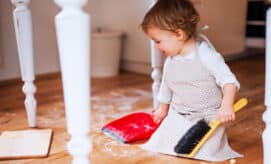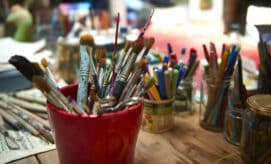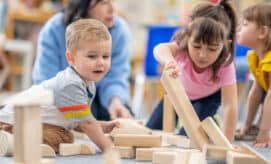Children love to explore the colors, textures, sights and sounds of nature, and research tells us that playful learning activities that make use of natural materials contribute to children’s physical, social-emotional and cognitive development.
The authors of a research article published in Frontiers in Psychology write, “Nature-based environments function as a play partner that helps children to transform the perceptual world into a conceptual world, because it diversifies play, is sensory rich and it plays back. When playing in nature-based environments, children have the possibility to connect with it (nature) in an interactive way.”
As early childhood care and learning providers, we can bring the outdoors inside so that children can learn through nature no matter what the weather is like! Below, you’ll find five ideas for incorporating nature discovery into a wide range of your early learning curriculum activities.
5 Tips for Bringing Nature into Your ECE Classroom
1. Incorporate Nature into Art Projects
The colors, shapes, and textures of nature can add interest and opportunities for creative expression to almost any art activity. Pinecones, leaves, flowers, and twigs are examples of natural materials that children enjoy exploring and using in art projects. If you’d like some inspiration, take a look at the fun leaf-based art activities described in this G2K article from the archives.
2. Attract Wildlife Visitors for Observation
Place a bird feeder right outside of your classroom window and see what kinds of birds and animal visitors stop by. Bird feeders made of seeds invite birds to visit, and they are often popular with squirrels as well. (If your main interest is birds, there are some seed feeders available to purchase that are designed to make it difficult for squirrels to visit.) You can attract hummingbirds to your window or yard by hanging hummingbird feeders filled with sugar water.
Bird feeders can be purchased online, or you might consider inviting the children in your care to help you make your own feeder. Here are a few ideas to help you get started:
3. Bring in Plants
Placing potted plants in your classroom is a simple way to bring nature indoors! For a hands-on learning experience, invite the children to help you water and care for the plants, or you might invite children to pot some of their own plants and watch them grow.
4. Use Natural Items as Math Manipulatives
Incorporating natural materials into your classroom as math manipulatives is a great opportunity to explore nature while building foundational math skills. In an article for ORAEYC, preschool educator and curriculum writer Nicole Fravel shares some great examples: “Rock, shell and leaf collections make inexpensive sorting, counting and patterning materials. We made our own Montessori style counting spindle boxes using numbered cardboard tubes mounted on a flat sheet of cardboard. The children read the number written on each tube and placed the corresponding number of objects in each tube. I introduced the activity using twigs I had gathered from my backyard as counters.”
Find more ideas for incorporating natural materials into math exploration activities in this G2K article from the archives.
5. Create a Nature Documentation Center
Create a designated space in your classroom for children to explore nature and document their observations! A small table and a few chairs can become a science discovery and documentation center when you add observation tools like magnifying glasses, flashlights, paper, and drawing materials. Invite children to bring natural items they find outdoors, such as leaves, rocks, pinecones, flowers (and more!) to explore in the documentation center.
In an article for Edutopia, educator Julie Hunter describes the conversation and collaboration opportunities generated in a nature documentation center: “Creating a designated space gives students opportunities to further observe and ponder their found nature materials; it enables scenarios where students can partner and work together, and perhaps share and explain to fellow students what first drew them to collect their nature items.”





